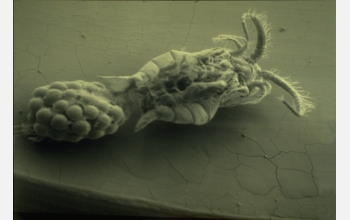Multimedia Gallery
Female, Cholera-carrying Copepod
A microscopic view of a female, cholera-carrying copepod.
More about this Image
For more than 20 years, the National Science Foundation (NSF) and other agencies have supported research on cholera led by former NSF director Dr. Rita Colwell. Colwell and her colleagues have tracked the disease and developed ways to stop the massive outbreaks it causes. Vibrio cholerae is a bacterium that can contaminate untreated water supplies and cause major epidemics, leading to sickness and death.
Colwell's ongoing research has disproved many commonly held theories about the bacterium, including how it travels the world, how it transmits to humans, and in particular, where it goes between outbreaks. Scientists had long questioned how V. cholerae could seemingly disappear--undetected in water samples; no new cases reported--and then almost spontaneously arise again. Solving this mystery became a primary focus of Colwell's research.
In the late 1970s, a small cholera outbreak occurred near New Orleans, La., that was limited to a few people, all of whom had eaten crab from a local bayou. However, when water samples were taken, instead of using traditional testing methods, Colwell tried a new detection method using an antibody that would latch on to a key component of the bacterium's cell membrane. Linked to the antibody was a molecule that would fluoresce under ultraviolet light. Using this method, she was able to detect V. cholerae in the water sample. Colwell discovered if conditions are not right for replication, V. cholerae's metabolic rate will plummet, causing it to shrink 15- to 300-fold and go into a dormant, spore-like state. This nonculturable state is essentially a survival tactic for the bacterium, enabling it to live in a wide range of conditions and habitats, including seawater, brackish water, rivers and estuaries. Additionally, Colwell discovered that the bacteria are just as infectious in the dormant state.
She then took this information and applied it to her cholera research in Bangladesh. Here, where cholera is endemic or recurs seasonally, the dormant bacteria were hiding among the plankton, microscopic plants and animals that inhabit many bodies of water. Additionally, she found a clear association between V. cholerae and copepods--tiny crustaceans in the zooplankton family. Wherever she found one the other was apparent as well. The V. cholerae cling to the backs of the copepods for mobility and colonize their intestines.
Exactly what awakens the bacterium from their dormant state is unknown, but it is thought to involve a combination of the "right" conditions such as water temperature and water salinity. For example, Colwell found that a graph compiled from satellite data showing seasonal peaks in sea surface temperature in the Bay of Bengal correlates with the seasonal peaks in admissions for cholera in local hospitals. Not long after the rise in sea temperature comes a rise in cholera admissions.
Colwell and researcher Anwarul Huq, her colleague from the University of Maryland Biotechnology Institute, are in the process of determining what the exact relationship is between sea temperatures, phytoplankton blooms and cholera cases. They hope to ultimately use this information to fight cholera on a larger scale, including the possible development of a global cholera warning system, employing both molecular genetic and remote sensing (satellite) technology.
Until then, seeking methods to keep cholera will be a continual challenge for scientists but there are small steps that can be taken. For example, while working in Bangladesh, Colwell devised a simple method to filter plankton and bacteria when collecting drinking water by covering the mouth of the jar with several layers of sari cloth. The cloth acts as a sieve, filtering out the plankton and particulate matter, thereby removing 99 percent of V. cholerae since these bacteria are predominantly attached to the plankton.
Credit: Courtesy Dr. Rita Colwell and Anwarul Huq
Images and other media in the National Science Foundation Multimedia Gallery are available for use in print and electronic material by NSF employees, members of the media, university staff, teachers and the general public. All media in the gallery are intended for personal, educational and nonprofit/non-commercial use only.
Images credited to the National Science Foundation, a federal agency, are in the public domain. The images were created by employees of the United States Government as part of their official duties or prepared by contractors as "works for hire" for NSF. You may freely use NSF-credited images and, at your discretion, credit NSF with a "Courtesy: National Science Foundation" notation.
Additional information about general usage can be found in Conditions.
Also Available:
Download the high-resolution JPG version of the image. (674 KB)
Use your mouse to right-click (Mac users may need to Ctrl-click) the link above and choose the option that will save the file or target to your computer.

